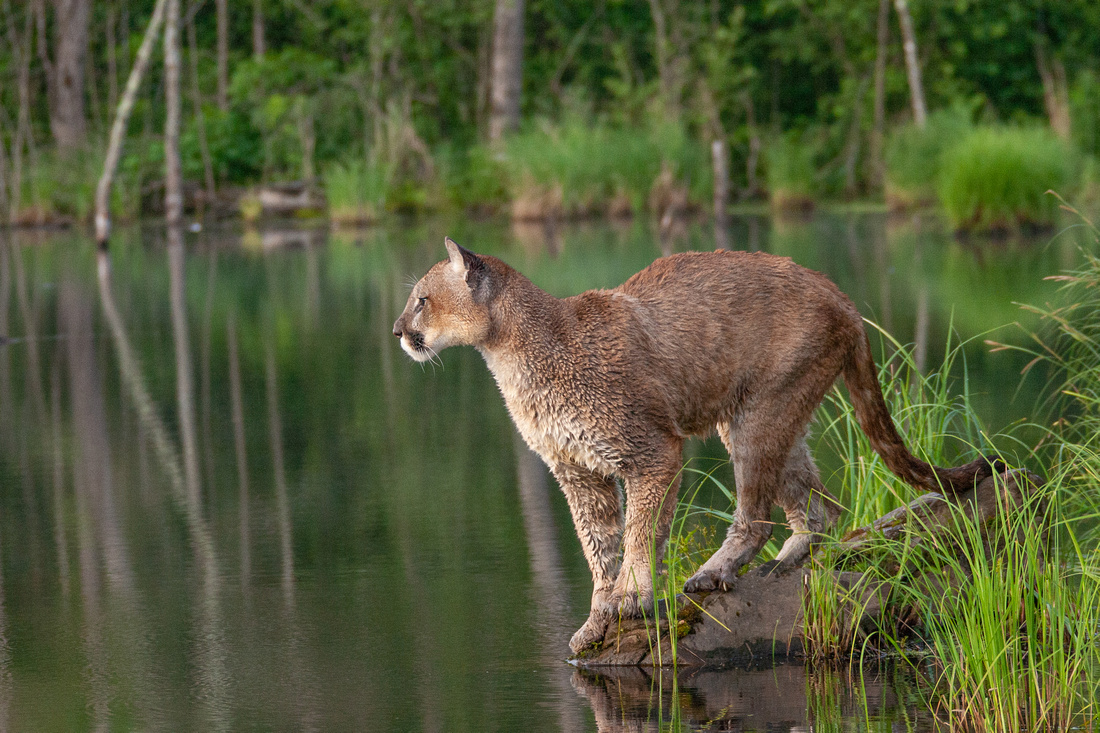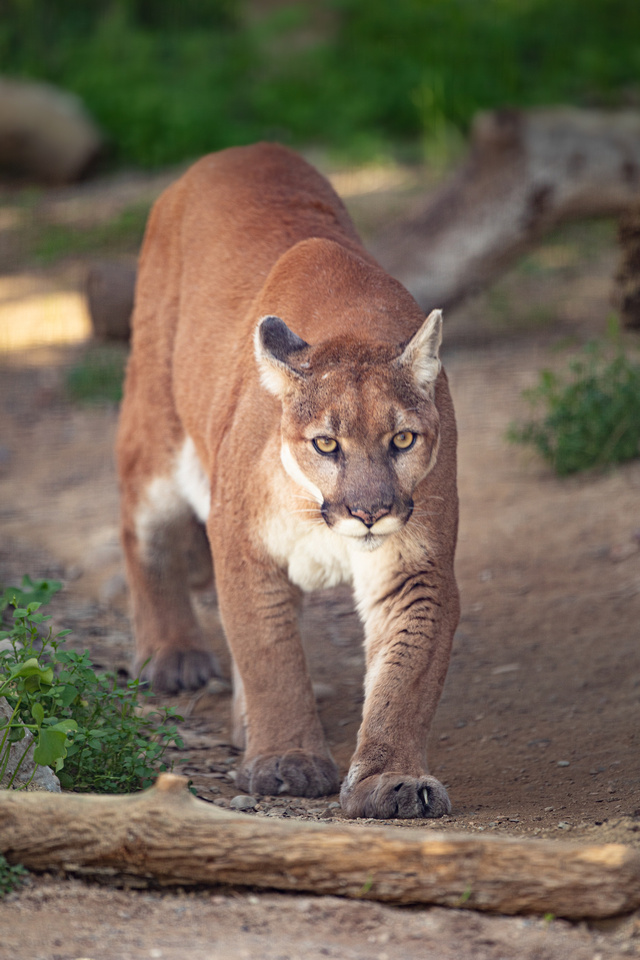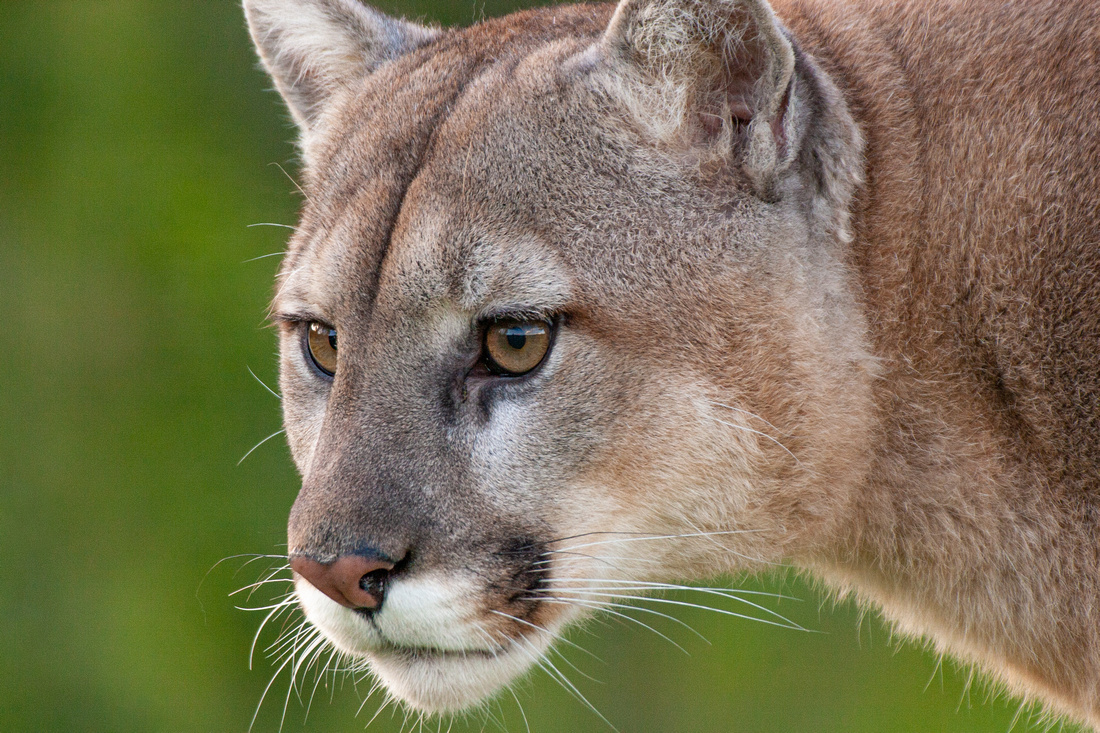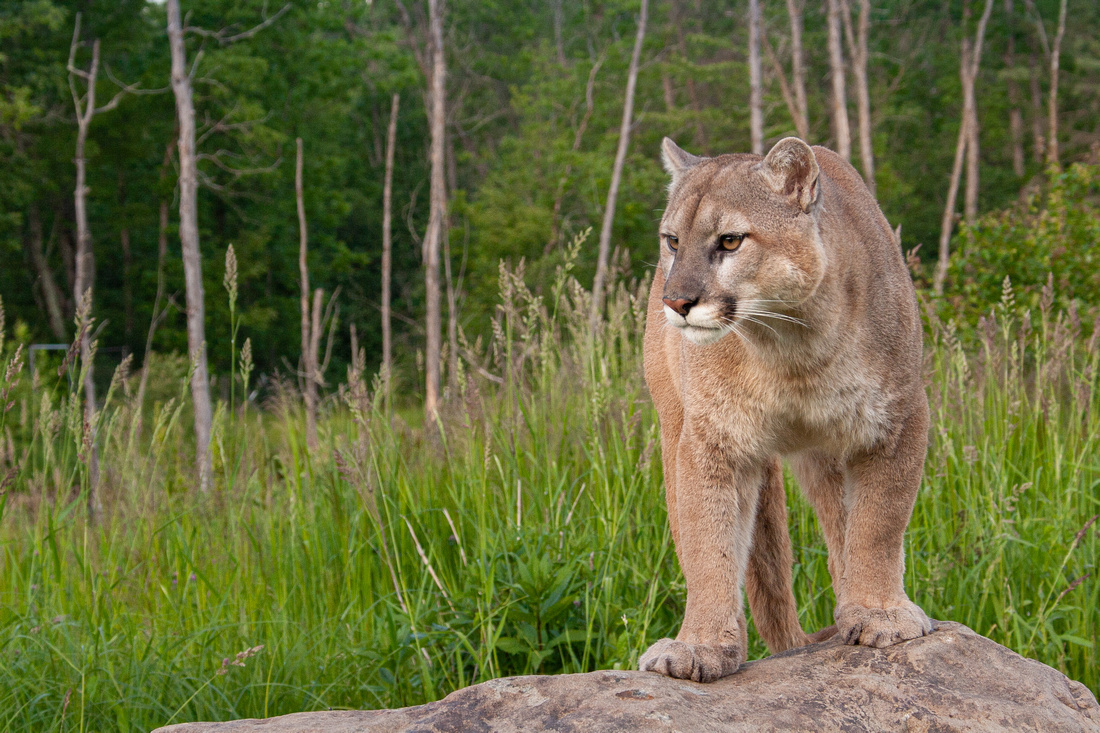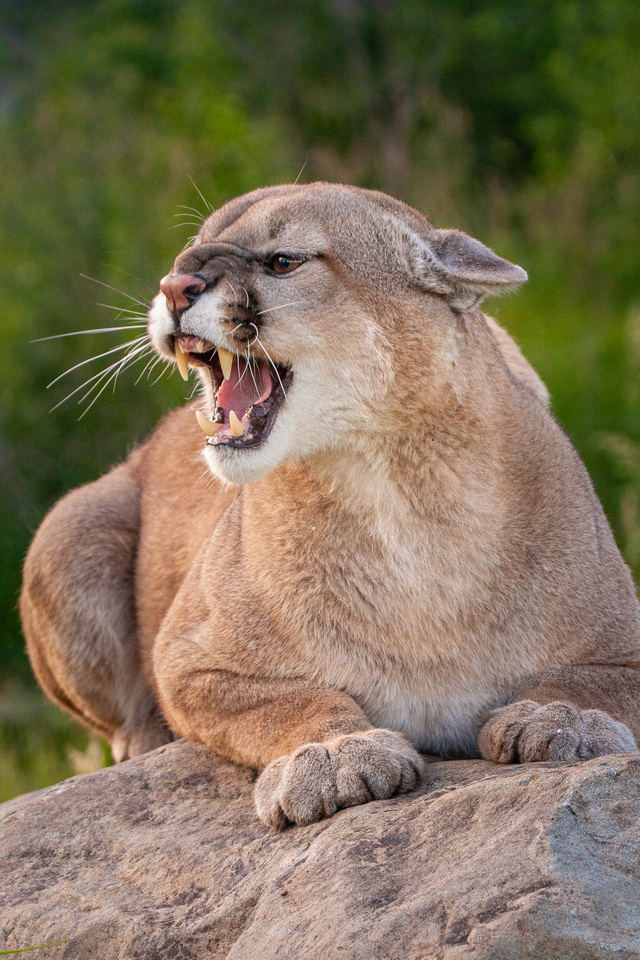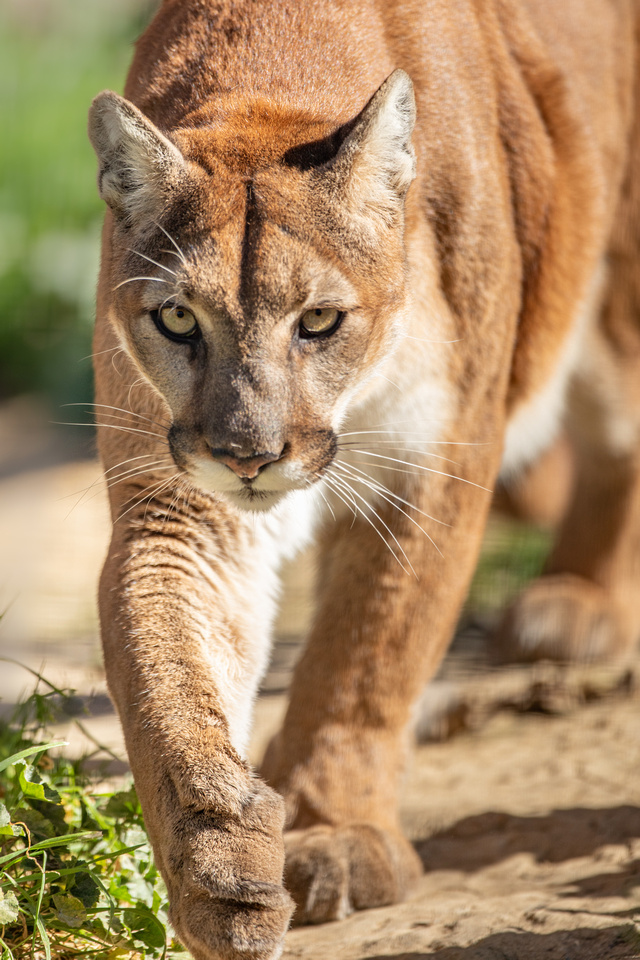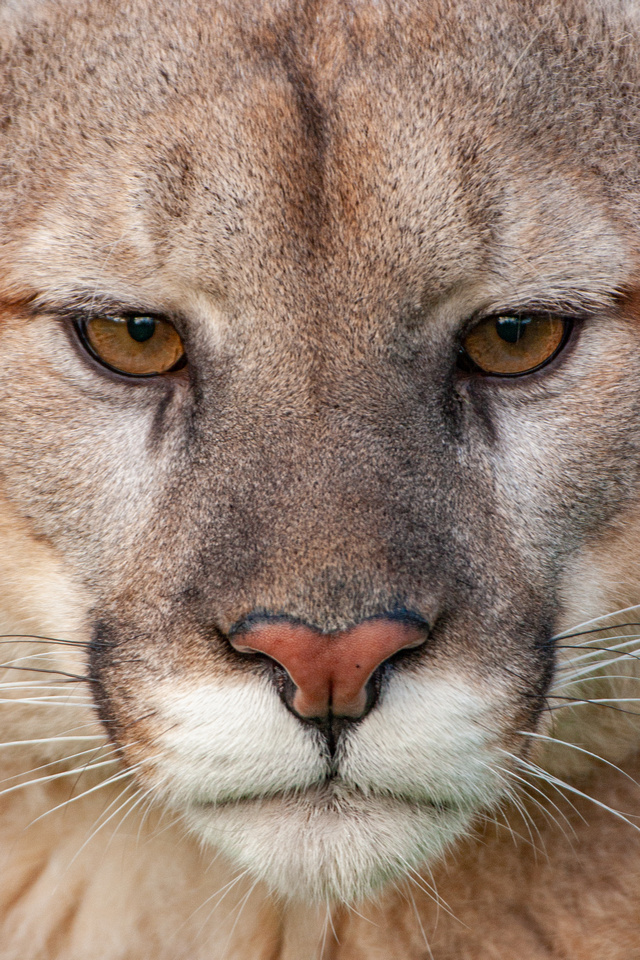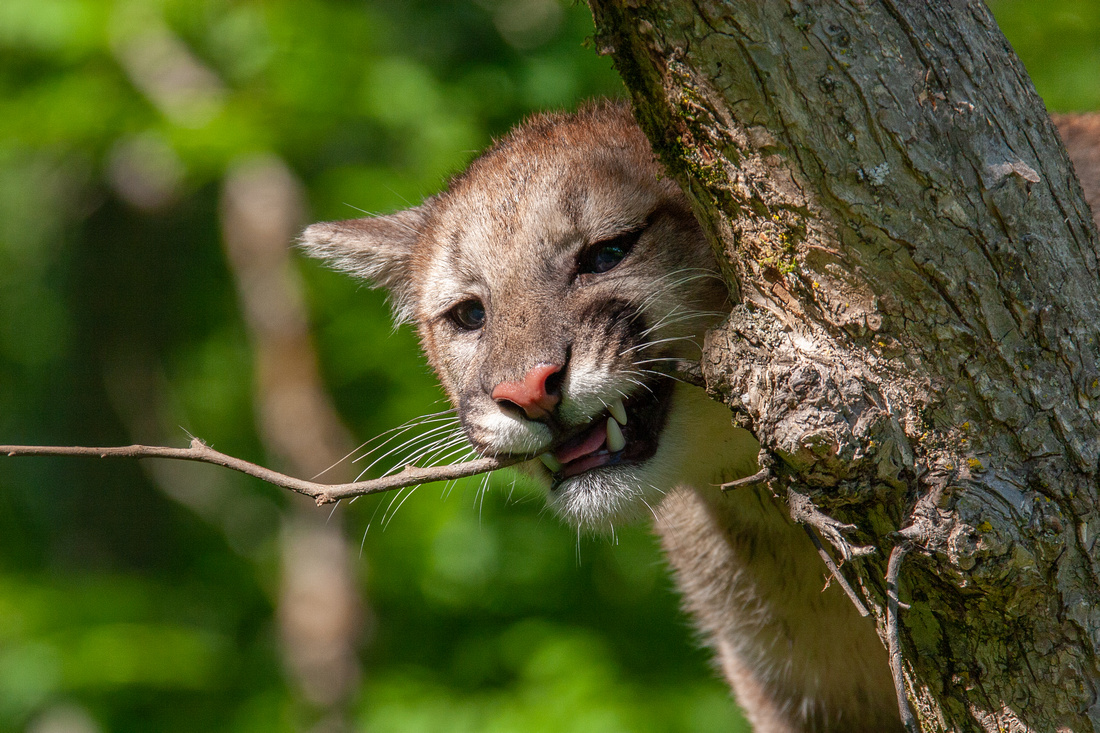Species highlight: Mountain Lion
Species Highlight: Mountain Lion
Text and photos by Heather Cline
The mountain lion goes by many names including puma, cougar, and panther. It's scientific name is Puma concolor and it is the largest of the "small cats." Mountain lions are members of the Puma lineage in the family Felidae. They have a long evolutionary history.
The thought of encountering a mountain lion on a trail strikes fear in a lot of people but the truth is only about 20 people have been killed by mountain lions over the past 100 years and humans are not on their preferred menus. These magnificent creatures prefer to stay away from humans and are quite adept at avoiding us entirely. Despite the facts, there is still a perception that these animals are lurking in shadows, waiting to pounce. This article is intended to provide information to provide a better understanding of the mountain lion and its significance in our ecosystem.
Size
- Adult male: 7 - 8 feet long / 140 - 175 lbs
- Adult female: 7 - 8 feet long / 110 lbs max
- Mountain Lions stand between 2 and 2 1/2 feet from the ground to their shoulders
Fun Fact: If you think you have spotted mountain lion tracks, check for claw imprints. Like all cats, mountain lions retract their claws when they walk, so if you see claw imprints in the tracks, it's likely a dog.
Lifespan
8 - 13 years in the wild, and up to 21 years in captivity
Fun Fact: a major city in the Inca civilization named Cusco was built in the shape of a cougar. This shows the admiration the Incas had for this amazing animal.
Anatomy
Mountain lions look very much like over-sized short-hair domestic cats. They have small heads with short faces. Ears are rounded and small. Their bodies are long and sleek, with long necks and tails.
- Body temperature: Slightly warmer than humans at 101-102 degrees fahrenheit
- Coloration: tawny-beige fur, except for the whitish-gray belly and chest. Black markings decorate the tip of the tail, ears, and around the snout
- Tails: Mountain lions have a long, heavy tail which can be 1/3 its body length. Used for balance and rudder-like direction changes when chasing prey, it's thick and muscular with a dark tip.
- Hearing: Mountain lions have extremely sensitive hearing. They can hear frequencies in the ultrasonic range and are able to move their rounded ears together or independently to isolate sounds
- Vision: Mountain lions have extraordinary vision. They have round or oval pupils, which allows them to open as wide as possible at night, but close almost completely in bright light, which protects light sensitive cells
Fun Fact: The mountain lion's sense of smell is not thought to play a large role in acquiring food and is thought to be more important in social behavior, such as mating.
Speed & Agility
Mountain lions powerful hind legs give them the ability to jump 15 feet high (usually for climbing trees) and 40 feet in distance. They can climb over a 12 foot fence. While they are not distance runners, they can sprint up to 50 mph and travel many miles at a rate of 10 mph.
Encounter Fact: In the highly unlikely event you encounter a mountain lion in the wild, make yourself look larger by waving your hands in the air and speak in a loud, firm voice, and clap your hands. If that doesn't scare the lion off, start throwing stones or branches in its direction. If a mountain knows you are aware of it, it isn't likely attempting to hunt you.
Diet
Mountain lions are stealthy predators, hunting at night and often lying in wait for prey or silently stalking it before pouncing from behind and delivering a lethal bite to the spinal cord. Typically they prey on deer, but also feed on a wide variety of other animals, including elk, bighorn sheep, and smaller wildlife species such as rabbit, turkey, raccoon and porcupine, rodents, even insects, when necessary. Like all cats, mountain lions are strict carnivores, and they only rarely consume vegetation.
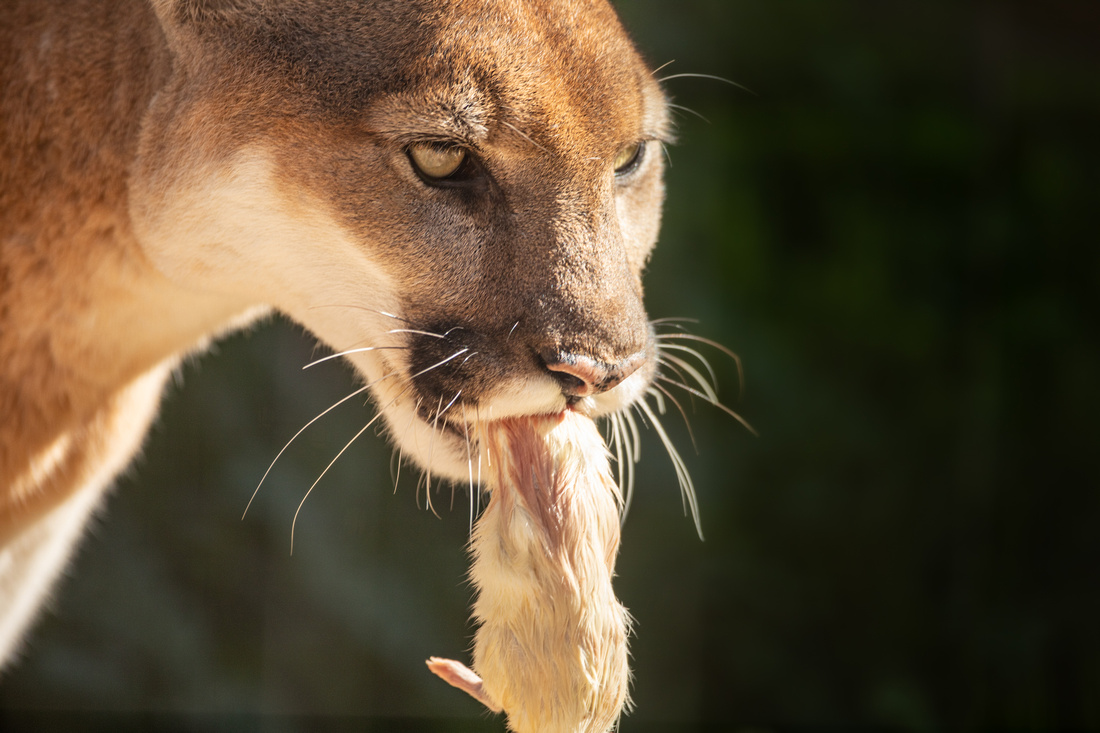

Fun Fact: Mountain lions play a crucial role in managing deer populations. When both wild game and domestic animals are accessible and available, research suggests that they prefer wild prey.
Social and Breeding Behaviors
Mountain lions are most active at dusk and dawn, known as crepuscular.
While mountain lions have been known predominantly as solitary animals, a study performed in partnership with UC Davis, Panthera conservation group, and American Museum of Natural History found that every single mountain lion they tracked fed from a carcass at the same time as another cat and some were repeat dining partners.
A single mountain lion requires 50 to 100 square miles to breed, raise young, and hunt. Both males and females are highly territorial and maintain and defend their chosen home ranges from other cougars. Females can be tolerant of slight overlaps in their territories with other females. However, males will defend their home ranges against transgressions by other males.
Mountain lions mate throughout June and July. After a gestation period of 3 months, females will give birth to a litter of 1 to 6 kittens. These kittens are born with spotted coats that they will eventually shed. Females won’t have another litter until 2 to 3 years later. Males play no role in rearing offspring.
Mountain lions advertise their availability for breeding through a system of feline communication which includes scent marking with scrapes (in tree bark or troughs in the dirt usually made with hind paws which are then often urinated or defecated on) and vocalizations.
Females do not try to reproduce until they have established their own territory. Females with cubs move from one place on their territory to another every few weeks. This helps her protect the cubs from roaming males and other predators.
Mothers spend an average of 18 to 24 months raising a single litter to maturity. The mother only nurses her kittens for the first seven weeks of their lives and the rest of the time is devoted to teaching the kittens how to survive on their own. Female mountain lions are dedicated mothers and are either pregnant or raising dependent kittens for the majority (over 75%) of their lives.
Fun Fact: Mountain lion cubs are born with blue eyes and spots. The spots turn to tawny colored fur in 6-9 months and their eyes to yellow within 16 months.
Communication
Mountain lions use a variety of communications in different circumstances.
- Loud, chirping whistles by young serves to call the mother.
- Touch is important in social bonding between mother and young.
- Scent marking is important in advertising territory boundaries and willingness to mate.
- Male cougars may shout when competing for female attention.
- Female mountain lions scream when they are in heat,
- Males may scream when in rivalry or to scare off the other males
Fun Fact: When displeased, the mountain lion will growl, hiss, and spit, but when they are content - they purr just like a household cat - only much louder.
Range and habitat
Mountain lions breeding populations are found in western Canada, the twelve westernmost states in the USA, as well as Florida, parts of Central America, and most of South America. There is no breeding population in Minnesota, but dispersing individuals pass through while looking for a mate or territory.
The historic range of the mountain lion included almost all of North and South America. The species was so wide-reaching and populous that it had multiple subspecies that varied based on location. Throughout the 1800s and early 1900s, people feared the mountain lion because it posed a risk to their livestock. The species was aggressively
hunted and almost eradicated from the eastern United States. Due to conservation efforts, mountain lion populations in the western United States are stable, although far lower than they were historically. While there are still several thousand mountain lions in the wild, their population has significantly decreased from their historical population due to unsustainable hunting, habitat destruction, and conflicts with livestock.
Mountain lion habitat can vary greatly. They can be found wherever deer are present. Their usual habitat is steep, rocky canyons or mountainous terrain. Mountain lions can be found in deserts as well as coastal forests, and from sea level to 10,000-foot elevations.
A mountain lion’s home range may span over 100 square miles for males, and 20 to 60 square miles for females.
Fun Fact: Aside from humans, the mountain lion has the widest geographic range of any land mammal in the Western Hemisphere
Predators and Threats
The greatest cause of mortality in many cougar populations is human-related, through sport hunting, illegal poaching, lethal removal of cougars that prey on livestock or domestic animals, and auto-related deaths. Mortality in dependent kittens is often caused by the death of their mother for any of these reasons; the orphans die of starvation or, without knowledge of proper behavior, become “problem cats” that are subsequently removed from the population.
Conservation Fact: The passage of the California Wildlife Protection Act of 1990 (Proposition 117) by California voters established that mountain lions are a "specially protected mammal" in California. It is unlawful to possess, transport, import or sell any mountain lion or part or product thereof (including taxidermy mounts).
Human and Mountain Lion Encounters
There are misconceptions about mountain lions that paint them in a villainous light but nothing could be farther from the truth.
- A mountain lion sighting is an indication that mountain lion populations are increasing in area. False. Often times, when a mountain lion is spotted, it is a young male who don't always make the best decisions and may be coming into an area because an older male has been killed or died. Mountain lions are generally solitary and are territorial so if a young male may enter a new territory based on the absence of another male, it isn't likely to understand how to avoid humans yet.
- Mountain lions encountered on public trails and spaces are looking to attack humans. False. Humans are not on the preferred diet plan for any mountain lion and in the cases where a mountain lion has attacked, it was typically when the animal was older or desperate for food, which is highly unusual.
- If I recreate in mountain lion country, I am likely to be attacked. Fales. The truth is, you are more likely to be struck by lightning than attacked by a mountain lion.
- An encounter with a mountain lion means it is stalking you or wants to attack. False. If a mountain lion was stalking you, you probably wouldn't know it. They are highly successful as ambush predators. If the mountain lion knows you are aware of it, it isn't likely on the hunt, but more likely trying to defend its offspring or less common - a curious young male.
Mountain lions are an "umbrella species" for conservation because their conservation depends on the preservation of large amounts of habitat. A mountain lion usually requires about 13 times as much area as a black bear or 40 times as much area as a bobcat to thrive. By preserving enough wilderness to support a stable mountain lion population, countless other species of plants and animals that share mountain lion habitat benefit. Mountain lions play a vital role in not only supporting the health and function of ecosystems on the whole, but also by promoting biodiversity.
I hope you enjoyed this focus on the mountain lion. To see more Mountain Lion photos, check out my gallery here.
Comments
Thank you!
Truman
